|
For each performance assessment in the PALS
library, information on the task is shown on the Administration
Procedures page and on the Task with Student Directions page. When
adapting a performance task, you will need to examine the content
on both of these pages. The text below shows a sample adaptation
of the Administration Procedures for the "Containers" performance
task. The second page shows a sample adaptation of the Task with
Student Directions. notes explain the changes and
Containers
|
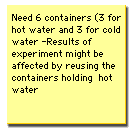 |
Three containers (or
cups) marked A, B, C Six
containers (or cups) marked A, B, C, D, E, F
Three thermometers
A clock or watch
A container with very hot water
A container with very cold water
 |
Pieces of card to use as a fan, if desired
A roll of paper to wipe up spills
A measuring cup
Advance Preparation
A supply of very hot water must be prepared ahead of time and a procedure established for students to safely access and use the supply. A supply of ice water must also be prepared.
Station Setup: Check that all of the equipment listed below is provided.
| 3 containers 3 containers for hot liquids and 3 containers for cold liquids (total of 6) |
The containers must be approximately the same size and shape. Each set should include containers made of different materials and must give measurable differences in cooling rates and heat retention. One ceramic, one metal, and one paper or Styrofoam (such as disposable coffee cups) are recommended for each set. A metal can of approximately the same volume as the other containers with the top cut out may be used as one of the containers. Label the containers for the hot liquid A, B, and C. For the cold liquid label the containers D, E, and F. |
|
|
3 thermometers |
Standard Celsius thermometers, approximately 10oC to 110oC. They should be identical, and they should be pretested together in a container of water to ensure that they agree. If these are unavailable, be sure the thermometer used can be read to a degree (estimates to 0.5 degrees). Administrators must make sure students know whether the thermometer is calibrated in Fahrenheit or Celsius degrees. For safety and improved accuracy, the administrator may wish to support the thermometers by fastening them to a stand or some other support. Since the students' later readings are compared only with their own earlier ones, whether or not the thermometer touches the container does not significantly affect results on the task. Administrators will determine the safest and most trouble free set up, given their equipment. |
|
|
Hot water |
A source of hot water is required. Best results are obtained if you use near boiling water. In this case, for safety reasons, pour the waste yourself into the containers for students at this station when they are ready to begin. You may also wish to stabilize the containers by placing all 3 in a box or pan with low sides, in case hot water is spilled. The experiment will not yield results if the starting temperature is close to room temperature. |
|
|
Cold Water |
A source of cold water is required. Best results obtained if you use ice. The experiment will not yield results if the starting temperature is close to room temperature. |
|
|
Clock or watch |
Provide students with a watch or call their attention to the wall clock. It is preferable, but not necessary, that the watch measure time in seconds. A stop watch is not desirable but may be used if the students are instructed to use it merely as a watch and not stop it at each measurement. |
|
|
Measuring cup |
6 or 8 oz measuring cup should be provided if the containers provided are not calibrated. |
|
|
Pieces of card |
Pieces of card, about 3 x 5 in (7 x 12 cm) or slightly larger are suitable. Students may or may not choose to use them as a fan. |
|
|
Towels |
Paper or cloth to wipe up spills and to wipe out the beakers when the activity is completed. |
|
|
Booklets |
A student booklet for each student that will perform this task. |
Safety Concerns:
Because this task involves students accessing very hot water, it is imperative that you establish and explain to students the safety concerns. Be sure to discuss the dangers that hot water pose with the entire class.
Note for the Administrator:
One of the things this task measures is student ability to read the thermometer, but the entire task need not be failed because of a lack of this skill. If the thermometer itself has any peculiarities, such as being calibrated in both Celsius and Fahrenheit, you will have pointed this out to all students before the testing session begins.
However, if an individual student is making gross errors in handling the thermometer, such as putting it in the liquid upside down, after 3 to 4 minutes you may intervene. Indicate on the student booklet that the student could not obtain measurements without assistance, and cite exactly what kind of assistance was given. This will allow the student to proceed with later questions in the task, and allow the coder to record the lack of skill with the equipment.
Note that assistance is only provided if the student decides to measure temperature and cannot use the equipment, not if she or he simply touches the containers and records "hot, cold,..." Do not provide any instructions about measuring volume. It may or may not occur to some students that volume is a variable that could be measured or controlled. Do not provide any assistance if the student is using the equipment correctly but is not able to read the thermometer.
Task Background:
In general, this was a difficult task for fourth graders. Although
most students in most countries were able to use a laboratory thermometer,
in many cases, the data gathered were incomplete or contained small
inaccuracies in measurement. Students did reasonably well in identifying
the container that keep water hottest, but almost none could explain
insulating capacity in terms of the materials from which the containers
were made.
An interesting misconception appeared when students were asked to
apply their findings to a different situation - that of keeping
ice cream cold. While 15% of students internationally recognized
that the container that was best for keeping a hot drink warm would
also be best for keeping ice cream cold, almost none could explain
why. About one-quarter of the students seemed to see the ice cream
as an opposite case, explaining that the container in which the
temperature of a hot drink declined most rapidly would be the one
to keep ice cream cold the longest.
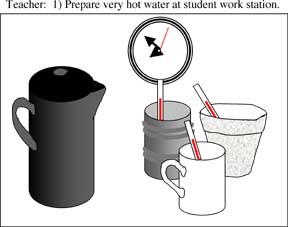 |
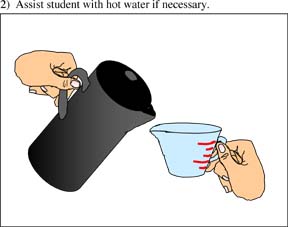 |
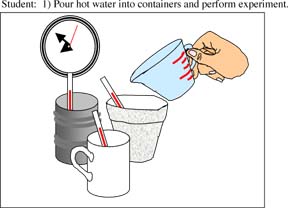 |
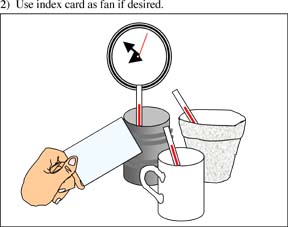 |
Click
here to see another example of how to adapt the task
continue with task design, or learn more about it before you go on.